Medical expert of the article
New publications
Preparations
Treatment of barley with antibiotics
Last reviewed: 07.03.2024

All iLive content is medically reviewed or fact checked to ensure as much factual accuracy as possible.
We have strict sourcing guidelines and only link to reputable media sites, academic research institutions and, whenever possible, medically peer reviewed studies. Note that the numbers in parentheses ([1], [2], etc.) are clickable links to these studies.
If you feel that any of our content is inaccurate, out-of-date, or otherwise questionable, please select it and press Ctrl + Enter.
Barley on the eye is a disease that sooner or later almost every person gets acquainted with. Someone suffered the disease at an early age, others were unlucky much later, while others suffer barley several times in a row. The pathology itself, which resembles cereals, except that the process of aging, despite the unsightly appearance and unpleasant symptoms, seems quite harmless. After all, since ancient times the main medicines from barley were strong tea, diluted alcohol and boiled egg. But is everything so simple actually, and why do doctors often prescribe such serious antimicrobials as antibiotics with barley on the eye, which, it would seem, itself must pass after 3-5 days?
Briefly about barley on the eye
Barley, or gordoleum, as sonically dubbed by medical workers, is considered not just an inflammatory, but a purulent-inflammatory rapidly developing process. It can originate in the hair bulb of the cilium or the sebaceous gland of Zeiss on the eyelid. This barley is called external, it is with him most often and the doctors face.
If the purulent-inflammatory process began in the meibomian gland, it is an internal barley, which by its nature is already considered an abscess and fraught with various complications. The inflammatory reaction in this case can become chronic, and then an even more unpleasant phenomenon called halazion is observed.
Most often, barley appears on one eye, but with insufficient hand hygiene (for example, due to the habit of rubbing eyes with unwashed hands) can spread to the other eye. Barley can be either single, or consist of several elements of an inflammatory nature (multiple), in weakened people and in childhood is not uncommon and recurring barley.
The disease usually begins with a slight itch in that area of the century, where an inflammatory process is indicated. This symptom can occur even in the absence of redness.
A little later, there is redness, tenderness and swelling of the eyelid, the sensation of a foreign body in the eye, lacrimation. Somewhere on day 3 at the top of the swelling, you can see a yellowish vial with purulent contents. After a couple of days, the pus spontaneously comes out.
Swelling and redness after this hold for 1-2 days, after which there is no trace of barley.
In childhood, because of the imperfection of the immune system, patients have other symptoms. For example, fever, headaches, weakness. In some people, in response to the inflammatory process, there is also an increase in lymph nodes. The same symptomatology is characteristic of multiple or recurrent barley, which usually occurs in people with severely weakened immunity.
It used to be considered that barley appears mainly because of the negative effects on the eyes of drafts and dirty hands. In fact, this is not entirely true. The causes of the appearance of a red purulent tubercle on the eyelid are much greater, and almost all of them boil down to a bacterial infection against a background of reduced immunity.
The same hypothermia is dangerous for the eyes precisely because of the reduced immunity under the influence of cold, wind, moisture, drafts. But weaken the work of the immune system, and other factors: stress, heavy physical exertion, physical and mental overstrain. Reduces the body's defenses and various diseases (infectious diseases, gastrointestinal diseases, metabolic disorders), as well as drugs for their treatment.
Defective nutrition (especially severe diets) with a deficiency of nutrients needed by the body causes avitaminosis, which also weakens the immune response to the effects of pathogenic microorganisms.
Any purulent-inflammatory process indicates a bacterial component of the disease. The most common pathogens of barley on the eye are staphylococcal and streptococcal infections (although other types of bacteria can cause a purulent inflammatory process), because these microorganisms surround us virtually everywhere, including human skin and hair. You can detect them even on conditionally clean hands. So, it's enough just to rub your eyes so that the bacteria get on the mucous membrane, and with weakened immunity they begin to develop their violent activity.
Some types of bacteria in an inactive form can live in the body for years, not manifesting themselves at all, but it is only necessary to weaken the immune system, conditionally pathogenic microorganisms become active pathogens. Now they are able to cause the development of the inflammatory process in any part of the body, including the mucous eye. And help the bacteria actively spread to different organs internal parasites - worms.
The probability of the appearance of barley on the eye is higher in people with chronic diseases of an infectious nature, such as caries, tonsillitis, sinusitis, etc. A hereditary predisposition may play a role in the development of the disease.
The appointment of antibiotics with barley on the eye is due precisely to the fact that inflammation is always closely related to a bacterial infection that can not be destroyed by any other means than by antimicrobials.
Indications of the antibiotics in barley
Is it possible to cure barley on the eye without antibiotics? Why not. Treatment of the century with antiseptic or anti-inflammatory infusion (decoction of calendula flowers or chamomile, strong tea, aloe juice or alcohol, diluted water and other alternative means) plus warming up the boiled egg (dry heat) is a fairly effective treatment, but only at the initial stage of the disease. In other words, before the appearance of pus. With purulent inflammation, any warming is excluded.
In principle, with not too weak or normal immunity, such treatment is enough. Redness comes off, and barley does not form at all. However, in this case there is no guarantee that he will not remind himself again after some time, when immunity for some reason will give the slack.
Very often you can see this situation: the barley cured by alternative methods appears again after 1-2 months. Why is this happening? It's very simple, the use of antiseptics does not allow the complete destruction of the bacterial infection, it just weakens for a while and becomes inactive. Reduced during illness, immunity plus the impact of negative factors (the same cold, stress, repeated infection) cause a new outbreak of the disease.
To avoid this, you do not have to self-medicate the old "proven" recipes, and seek help from a therapist or ophthalmologist. They already know for sure that a bacterial infection, and even more so in the head (which is fraught with the development of inflammatory processes in the brain), must be destroyed definitively and irrevocably. And you can do this only with the help of antibiotics.
Antibiotics with barley on the eye can help avoid dangerous complications and spread the infection to other organs. Agree, it is very difficult during the treatment of barley and other inflammatory pathologies of the eyes to maintain around them a sterile purity. No, no, and the hand will stretch or rub your eyes. And what can we say about children who rub their eyes with dirty fists about and without it. And dust in the room or on the street, containing bacterial fragments, can easily get on the affected eyelid, complicating the course of the disease.
As we see, the danger of complication exists always, no matter how hard I try to protect the sore spot from negative factors. Antibiotics, however, in the form of drops and ointments will not spread any old or new infection, which means that the disease will pass easily and it is unlikely to return so quickly.
Absolute indications for the use of antibiotics in barley are its atypical forms: multiple and recurrent barley. The latter is in some way a chronic form of the disease, which at any time can acquire complications in the form of conjunctivitis, halazion, etc. No less unpleasant pathologies. A plural barley, which in some cases affects the entire eyelid around the perimeter of the eye, is itself difficult to treat and threatens with dangerous complications.
With complicated pathologies, antimicrobial agents can be prescribed for both external and peroral use, i.e. Antibiotics in the form of tablets. They can be prescribed for both relapsing and multiple, and with internal barley, which can have life-threatening complications on the brain.
A doctor can prescribe popular antibacterial drugs if the disease has a traditional form, but for some reason it is not easily treatable by other drugs and alternative methods. This is necessary to prevent the spread of bacterial infection, and also to prevent the disease from becoming chronic.
Release form
So, antibiotics with barley are needed to combat bacterial infection, which becomes the cause of purulent inflammation in the century. The fact that barley is located outside the eye, speaks in favor of the use of external agents that directly affect pathogenic microorganisms in the area of their localization, bypassing the gastrointestinal tract.
Antibiotics for topical application include drops and ointments with an antimicrobial component. The positive side of such drugs is that they do not have an irritant effect on the gastrointestinal mucosa and do not have a toxic effect on the internal organs (liver, kidneys, etc.).
Drops can be used both in the evening and during the day. Usually they do not impair visual perception. The only inconvenience is that the solution can not stay for a long time for a century and flows down.
Ointments with antibiotics in this regard are more attractive, because they envelop the affected area, due to which they can effectively fight bacteria and protect the eye from getting infection from the outside for a long time. But in the daytime it is not very convenient to use this form of antibiotic, as it forms a translucent film on the eye, which does not go away immediately, and an ugly fat coating remains for a century.
Whatever were convenient and useful antibiotics in the form of ointments and drops, with a greatly weakened immunity there is always the possibility of spreading the infection inside the organism or activating the internal conditionally pathogenic bacteria. To prevent this, doctors prescribe antimicrobial agents for internal admission that fight infection, nesting both inside and outside. In this case, the use of external means remains an obligatory component of complex antibacterial treatment of barley.
If it is not possible to take oral antibiotics, they are given an injection. For these purposes, use antimicrobials in ampoules.
Consider some names of antibiotics used in barley in various forms of release:
Eye drops: Albucid, Levomycetin, Tsiprolet, Floksal, Sofraks, Penicillin 1% solution, Gentamicin, Erythromycin, Torbex, and others.
Ophthalmic ointments: "Tetracycline ointment", "Erythromycin ointment", preparations "Floxal" and "Torbex" in the form of ophthalmic ointment, "Eubetal et al.
Antibiotics for systemic use: Doxycycline, Ampicillin, Augmentin, Azithromycin, Gentamicin, Zitrolide, Cefazolin, and others.
Dosing and administration
Since the majority of patients turn to the doctor late, when the itching and slight reddening are already passing into the eyelid edema around the bright red tubercle (with pus or while without it), the question is whether to start using antibiotics or even wait (suddenly the barley itself will resolve !), usually does not arise. Recall that barley is a rapidly developing pathology of an inflammatory nature, which means that the edema and suppuration begins within the first 2-3 days.
Many patients turn to the doctor when they see that self-treatment with "grandmother's" methods gives the opposite result: barley not only does not descend, but spreads to the entire surface of the century and even to the other eye. There is no way to do without antibiotics.
Usually doctors immediately prescribe antibiotics in the form of eye drops and ointments, stipulating the moment that eye ointments are better taken at night, and drops in the daytime. In principle, you can use one version of the drug, the main thing is that it does not have allergic reactions.
The doctor decides on the appointment of pills and injections based on the patient's condition. If the disease has a large area of distribution, as in multiple barley, or is fraught with complications (recurrent and internal barley), antibiotics are systematically prescribed for systemic administration. The same is true if the disease has already caused complications.
The choice of antibiotics in barley is reduced to broad-spectrum antimicrobials. The fact is that barley is developing at such a rate that there is no time to do an analysis for the pathogen, in general. So you need to choose a drug that would cover all possible groups of pathogenic microorganisms that can cause the development of the disease.
When prescribing drops, preference is given to antibiotics of the penicillin line, active against the main causative agents of the disease (unprotected and protected penicillins). However, these drugs often cause dangerous allergic reactions from penicillin intolerance. In this case antibiotics from a number of macrolides become the drugs of choice.
Ointments can contain antibiotics of the tetracycline series, a group of macrolides and fluoroquinolones. Assigning drops and ointments in the complex can fully cover the entire spectrum of pathogenic microorganisms.
Applied in the therapy of barley and cephalosporins, which are useful in complicated pathologies. These drugs are administered mainly intramuscularly.
The method of administration and dose of antibiotics in barley depends on the form of release and the type of preparation. They must be coordinated with the attending physician in order to avoid symptoms of overdose and intoxication of the body, especially during the administration of oral means.
After the barley breaks and the pus splashes out, doctors recommend wiping the eyes with antiseptic solutions (for example, a solution of furacilin or sulfacil sodium, which is also called "Albucid"). Even if barley was only on one eye, both eyes should be washed, with separate cotton swabs.
And now consider the drugs that doctors prescribe with barley most often.
Ointments with antibiotic from barley
For treatment of barley, ointments containing antibiotics with a wide range of action of various groups are used. It is important that the active substance of the drug is effective for the treatment of ophthalmic infections, as indicated by the instruction for the use of the drug.
 [16], [17], [18], [19], [20], [21]
[16], [17], [18], [19], [20], [21]
Tetracycline ointment
Tetracycline is one of the antibiotics used with barley on the eye, because it can cope with a large number of pathogens of the inflammatory process in the eye area. It is this antibiotic that is the active substance of the drug. And to make it more convenient to use it for local treatment of the eye and the area around, lanolin and petrolatum are added to the antibiotic.

There are 2 types of ointments: 1 and 3 percent. In our case, as with other inflammatory eye diseases, only 1% ointment is used (tubes of 1.7 and 10 g). 3% treat skin diseases.
Pharmacodynamics. The principle of the drug is based on blocking the synthesis of protein in bacterial cells. The bactericidal effect is carried out at the level of the ribosomes.
Pharmacokinetics. Eye ointment acts locally and practically does not enter the bloodstream, so its pharmacokinetics
Contraindications. Eye ointment is considered to be relatively safe, so it can be used already from the period of newborn (for example, with bacterial conjunctivitis).
The only absolute contraindication to the use of 1% of the ointment is the individual intolerance of tetracycline and other components of the drug.
Use during pregnancy. After appropriate tests, its use is permissible even during pregnancy. Breastfeeding is best not to stop treatment.
Side effects. The use of ophthalmic ointment in most cases does without consequences. Rarely patients may complain of a worsening of appetite, attacks of vomiting, flushing or dryness of mucous membranes, photosensitivity. In some cases, there were also allergic reactions, including Quincke's edema.
Method of administration and dose. The ointment is applied to the eyelid in the affected area and not far around it. Apply the agent on the eyelid is recommended with a sterile cotton swab or a cotton-gauze swab.
The recommended dose of the drug is from 0.2 to 0.4 g. The ointment can be used 3 to 5 times a day. The course of treatment is 5-7 days.
Overdose. The use of external means excludes overdose.
Interactions with other drugs. Eye ointment with antibiotic should be used as an independent external agent. The use of local medicines with the same effect simultaneously with tetracycline ointment in ophthalmology is unacceptable.
Storage conditions. Ointment with an antibiotic is recommended to be stored in a cool room, protecting it from direct sunlight. Keep away from children.
Shelf life. Before opening a tube, the drug can be stored for no more than 2 years. If the integrity of the package is broken, use the product will need to be within 2 months.
Erythromycin ointment
The active substance of this ointment is erythromycin, an antibiotic from the macrolide group. In the composition of the ointment we also find petrolatum, lanolin and some other auxiliary components. Erythromycin ointment is sold in tubes of 10 g.
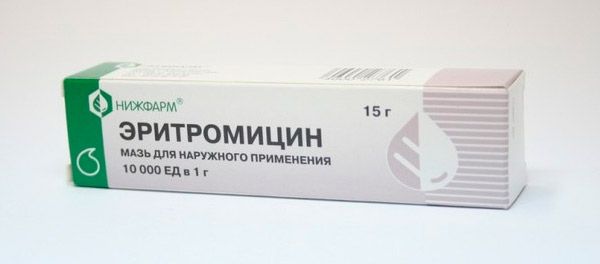
Pharmacodynamics. The drug has a pronounced bacteriostatic effect, i.e. Inhibits the reproduction of bacteria, which leads to a decrease in their livestock. Effective against gram-positive (staphylococcus, corynobacterium, clostridia) and some gram-negative bacteria.
It can be prescribed as a substitution therapy for intolerance to penicillins, as well as for controlling bacteria that are resistant to tetracyclines.
Contraindications. Ointment is not used when hypersensitivity to its components. With caution, antibiotics should be prescribed for patients with liver pathologies.
Side effects. Therapy with ointment with erythromycin is rarely accompanied by reactions of intolerance. In rare cases, there are dyspepsia, increased itching and redness of the mucous membranes, the appearance of noise in the ears, which worsens the auditory perception, tachycardia, and certain manifestations of allergy.
Long-term treatment with erythromycin may provoke the development of a secondary infection.
Method of administration and dose. The drug is used by analogy with tetracycline ointment. The recommended dose, depending on the severity of the pathology is from 0.2 to 0.3 g. Ointment should be applied to the affected area 3 times a day. The course of treatment is set by the doctor individually.
Interaction with other drugs. Antibiotics based on erythromycin is not recommended to be used concomitantly with caffeine, aminophylline, theophylline, cyclosporine, clindamycin, lincomycin, chloramphenicol due to the development of adverse reactions or the effect of treatment.
Since antibiotics for external use are not actually absorbed into the blood, their use should not be combined with external agents containing the above substances. During therapy with erythromycin ointment, it is not advisable to use scrubs because of the appearance of dryness and flaking on the skin and mucous membranes.
Storage conditions. Store the ointment manufacturers recommend in a room temperature, protecting from light. Keep away from children.
Shelf life. Ointment preserves medicinal properties for 3 years.
 [22], [23], [24], [25], [26], [27], [28]
[22], [23], [24], [25], [26], [27], [28]
Ointment "Floksan"
Quite an interesting drug, the active ingredient of which is fluoroquinolone ofloxacin. As auxiliary components are liquid paraffin, animal fat, petroleum jelly. Sold in tubes of 3 g.
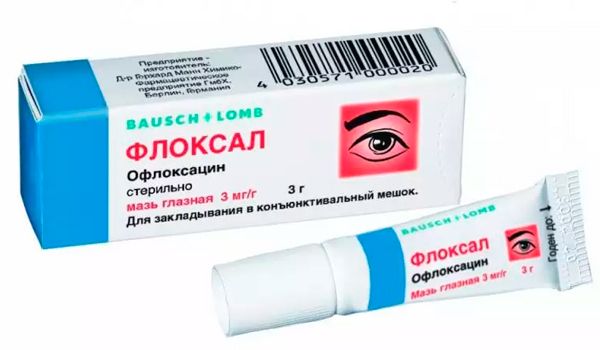
Pharmacodynamics. The drug has a pronounced bactericidal effect against a large number of bacteria that can cause inflammation in the eye tissues, including a large number of resistant strains.
Pharmacokinetics. It is able to accumulate in the vitreous body with repeated application. The half-life of the active substance with daily use ranges from 3 to 7 hours.
Contraindications. The drug is not used to treat barley in pregnant women and nursing mothers. It is inadmissible to use the drug in persons with hypersensitivity to its components.
Side effects. The use of the drug rarely causes unwanted reactions, which are also reversible.
Sometimes you can observe reddening of the mucous eyes, swelling of the face, lachrymation. Occasionally patients complain of dizziness, nausea, discomfort or burning sensation in the eye, short-term deterioration of vision clarity, dryness of mucous eyes, photosensitivity. Allergic reactions are rare.
Method of administration and dose. A small amount of ointment is recommended to be applied to the inner part of the eyelid 2 to 5 times a day (depending on the causative agent of the disease). The course of treatment is not more than 2 weeks.
The drug can be used in 2 forms of release: in the form of drops and ointments. Drops are recommended to be instilled in the eye 3-4 times a day. Single dose for 1 eye - 1 drop.
Interaction with other drugs. Not studied.
Storage conditions. Manufacturers recommend keeping the medicine at a low room temperature away from light and heat sources. Keep away from children.
Shelf life. Before opening the tube, the ointment can be stored for 3 years. If the integrity of the package is violated, the shelf life is reduced to 6 months.
Eye drops with antibiotic
If the ointment is more convenient to apply in the evening, eye drops with antibiotic in barley can be used at any time. They do not leave a fat coating for a century and do not change the quality of vision.
Drops of "Albucid"
This remedy on the basis of sulfacetamide (antibiotic from the group of sulfonamides) is very fond of ophthalmologists, and therefore, with barley and bacterial conjunctivitis, they are most often prescribed precisely these antibiotics. Sell the drug in the form of drops in bottles with a dropper volume of 5 and 10 ml.

Pharmacodynamics. The drug has a sufficient bacteriostatic effect, which allows you to quickly stop the symptoms of inflammation of the century. Effective against a large number of pathogens.
Pharmacokinetics. A small part of the drug is able to penetrate the bloodstream through the conjunctiva.
Use during pregnancy. It is allowed to apply the drug during pregnancy only after consulting a doctor and taking all risks into account.
Breastfeeding during therapy with Albucid is undesirable. In pediatrics it is used since the newborn period as a therapeutic and prophylactic.
Contraindications. The drug is not used to treat the eye, if the patient is diagnosed with hypersensitivity to the components of the drug.
Side effects. When instilled into the eye area, patients note a rapid-passing feeling of burning, pain or cuts in the eye. Some people note increased lacrimation, irritation of the mucosa, itching. Occasionally, allergic reactions of varying severity are observed.
Method of administration and dose. The agent is instilled in the eye for 1-2 drops at a time. Use the drug is recommended 4 to 6 times a day. The duration of the course of treatment is established by the attending physician.
Overdose. Exceeding the recommended dosage is fraught with increased side effects.
Interaction with other drugs. It is not recommended simultaneous therapy with "Albucidum" and preparations containing silver salts, as well as a joint application with Dicain and Procaín.
Storage conditions. Keep the medicine in the form of drops needed at low temperatures (within 10-15 o C), protecting from sunlight. Keep away from children.
Shelf life. Not opened bottle in the original packaging can be stored for no more than 2 years. After opening the container, the liquid should be consumed within 4 weeks.
Drops of "Levomycetin"
This drug is based on chloramphenicol, which is also considered a broad-spectrum antibiotic. Additional components are purified water and boric acid, which is successfully used in ophthalmology to cleanse the eyes. The sale comes in glass bottles with a rubber lid in a metal sheath.

Famacodynamics. Drops have a good bacteriostatic effect (in usual doses). Are active against a lot of pathogenic microorganisms, including strains resistant to sulfonamides and penicillin. Resistance to the antibiotic develops slowly, which allows it to be used for a long time.
Pharmacokinetics. The drug has a good penetrating ability, so it quickly seeps into the tissues and body fluids, including all parts of the eye, except the lens.
Use during pregnancy. Due to the excellent penetrating properties of the drug it is forbidden to apply during pregnancy and lactation.
Children can be prescribed a drug from a month old. Until then, it is used only as a last resort under the supervision of a doctor.
Contraindications. The drug is not prescribed for hypersensitivity to the components of the drug. Do not apply in the area affected by skin diseases, such as psoriasis, eczema, mycoses, etc.
Side effects. The drug may cause slight irritation and reddening of the mucous eyes, edema of the eyelid and itching. Sometimes there are also lacrimation, headaches, dizziness, allergic reactions in the form of skin itching and rashes on it. Against the background of intolerance of the drug there were cases of edema of Quincke.
Method of administration and dose. Such drops with antibiotics with barley on the eye and other bacterial pathologies of the eyes should be applied 3 times a day. To drip it is necessary on 1 drop on each eye (to avoid distribution of an infection to process it is desirable both eyes). The course of treatment is usually 1-2 weeks.
Overdose. A large single dose of levomycetin eye drops can lead to blurred vision. Usually everything is restored after washing the eyes with clean water in sufficient quantity.
Interaction with other drugs. It is not allowed simultaneous application of "Levomycetin" and other external agents for eye treatment. The interval between the use of drugs should be at least a quarter of an hour.
Drops for the eyes do not apply over the ointment.
Storage conditions. Storage of the drug is carried out at room temperature, protecting the drug from direct sunlight. Keep away from children.
Shelf life. In the original packaging, the drug retains its properties for 2 years. After opening the bottle, the antibiotic is used for 2 weeks.
Drops of "Tsiprolet"
The preparation is an aqueous solution of an antibiotic from the group of fluoroquinolones of ciprofloxacin. Effective even with severe purulent infections. On sale comes in plastic bottles with a dropper. Volume of 5 ml.
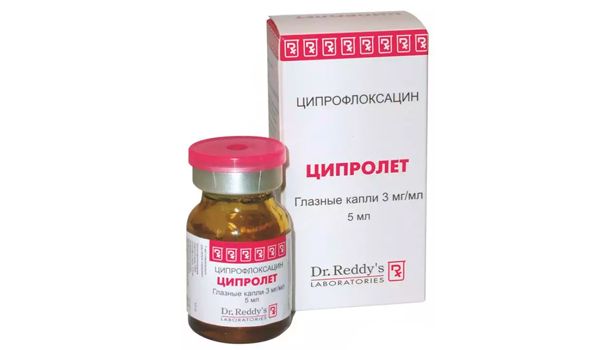
Pharmacodynamics. Ciprofloxacin has a bactericidal action against many pathogens of inflammatory eye diseases (staphylococcus, streptococcus, chlamydia, proteus, etc.). Not effective for controlling clostridia, treponema, bacteriosis and fungal infections.
Pharmacodynamics. Well penetrates into various fluids, including breast milk.
Use during pregnancy. Adhering properties of the drug are an obstacle to its use in the therapy of pregnant women and nursing mothers.
Contraindications. Do not apply drops of "Tziprolet" with intolerance of its components and hypersensitivity to fluoroquinolones, viral infections. In pediatrics appoint children over 1 year.
Side effects. The drug, like other local antibiotics with barley on the eye, can cause irritation of the tissues around the eye (burning, sensation of foreign particles in the eye, itching and redness of the mucous membranes). Occasionally, patients notice allergic reactions to the drug, temporary disturbance of visual acuity, development of keratitis or superinfection.
Method of administration and dose. Bury the drug in the eye is recommended up to 6 times a day. Single dose - 1 or 2 drops in each eye. In severe and complicated infections, you can apply at intervals of 1 hour, gradually increasing the time interval between instillations.
Apply strictly according to the doctor's prescription in the dosage indicated.
Overdose. Local application of drops excludes overdose by them.
Interaction with other drugs. The drug is well combined with other groups of antibiotics, which makes it possible and effective to use them together.
The incompatibility of ciprofloxacin is noted only in relation to drugs with a pH level of 3-4 units.
Storage conditions. Store the medicine with antibiotic in a room temperature, protecting from light and moisture. Keep away from children.
You can not freeze eye drops.
Shelf life. Bactericidal properties of the drug persist for 2 years. The opened vial should be used up within 1 month. The overdue medicine should not be used.
Despite the fact that external agents with antibiotics enter the bloodstream in an insignificant amount, they can not be used after the expiration date, since this can still cause intoxication of the body. Buying drugs for topical application should be monitored, so that the drugs are intended specifically for the treatment of the eye (eye ointments and drops). Preparations for the treatment of skin diseases may contain an increased concentration of active ingredient and auxiliary components that are not applicable in ophthalmology.
Antibiotics from barley in tablets and ampoules
With barley on the eye, characterized by a fairly severe course with a high probability of complications, in addition to external agents, doctors often prescribe antibiotics in tablets and injections. The preparation of choice is often tetracyclines and penicillins, including protected ones.
Doxycycline
"Doxycycline" is an oral preparation of the tetracycline series with the same active ingredient. The sale comes in the form of capsules, packed in blisters and a cardboard box (10 capsules in a blister pack).
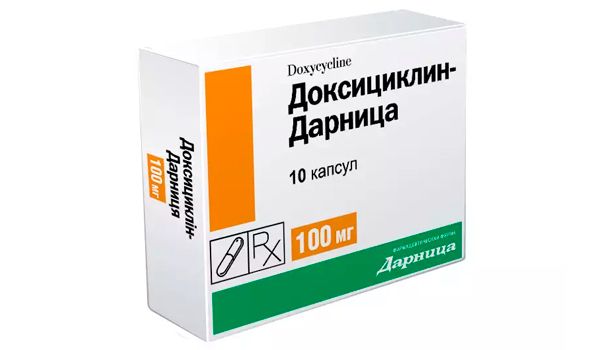
Pharmacodynamics. Has a pronounced bacteriostatic effect against a large number of gram-positive and gram-negative bacteria.
Pharmacokinetics. Doxycycline can be rapidly absorbed into the digestive tract, while providing a prolonged effect. The half-life of the drug can range from 12 to 22 hours. It is excreted in urine and feces.
Use during pregnancy. Not applicable because of the danger of penetration through the placental barrier. Breastfeeding for the duration of therapy with the drug is discontinued.
Contraindications. Do not use in porphyria and leukopenia. Absolute contraindications to the drug are hypersensitivity to tetracyclines and severe liver damage.
Side effects. Among the most common side effects can be identified: anemia, allergic reactions against hypersensitivity, skin rashes, headaches, dizziness, increased intracranial pressure, visual and hearing impairments, problems with the operation of the gastrointestinal tract, muscle and joint pains, hot flashes. Long-term use in large doses can cause the development of superinfection.
Method of administration and dose. Take medicine during or after a meal. Capsules are not chewed, but washed down with water.
The initial dose of the drug is 200 mg per day, the next day it is reduced to 100 mg per day. Therapeutic course is not less than 10 days.
Overdose. Happens extremely rarely. It manifests in the form of pancreatitis and kidney pain. Treatment consists of rinsing the stomach and taking calcium salts.
Interaction with other drugs. Antacids reduce the absorption of the drug in the digestive tract. Caution should be administered with quinapril, sulfanylurea derivatives and curare like agents. It is undesirable to apply in parallel with bactericidal antibiotics.
For other types of drug interactions, see the instructions for the drug.
Storage conditions. Store at room temperature for a shelf life of 3 years.
Among the antibiotics of the penicillin series, "Ampicillin" or preparations from a number of protected pacilliens ("Augmentin", "Flemoxin", etc.) are most often prescribed. With a negative reaction to penicillins, they are replaced with tetracyclines or cephalosporins.
Cefazolin
"Cefazolin" is the least toxic preparation of cephalosporin series in the form of powder for injection, which is also used in ophthalmology to combat bacterial infections. Possesses bactericidal action.
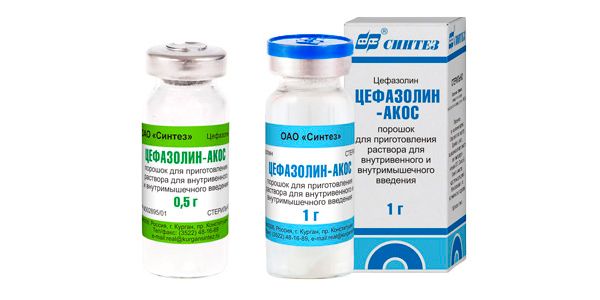
Pharmacokinetics. It is able to penetrate the placental barrier and enter into breast milk in small amounts. It is excreted by the kidneys.
Use during pregnancy. Limited.
Contraindications. Do not appoint if hypersensitivity to beta-lactam antibiotics, kidney failure, violations of intestinal permeability. Children are prescribed from 2 months of life.
Side effects. Most often, patients complain of allergic reactions (mild and severe) and dyspepsia. It can cause damage to the intestinal microflora and the development of superinfection.
Method of administration and dose. For injectable intramuscular injection, it is diluted with ice medicine. Dosage depends on the severity of the infection process. Usually 0.25 -0.5 g.
Interaction with other drugs. It is undesirable to simultaneously use cefazilin and probenecid, anticoagulants, diuretics. In combination with aminoglycosides, it intensifies the toxic effects of the latter.
Storage conditions. Store the drug in the original packaging at low room temperatures, protecting from light. Keep away from children.
Shelf life. Powder for the preparation of the injection solution retains its antibacterial properties for 3 years. It is desirable to use a freshly prepared solution within 24 hours.
The choice of effective antibiotics with barley on the eye is always with the attending physician, because only he can prescribe the treatment in accordance with the diagnosis and features of the patient's body. And if necessary, and make a test for the tolerability of the antibiotic.
 [43], [44], [45], [46], [47], [48], [49], [50], [51], [52], [53]
[43], [44], [45], [46], [47], [48], [49], [50], [51], [52], [53]
Attention!
To simplify the perception of information, this instruction for use of the drug "Treatment of barley with antibiotics" translated and presented in a special form on the basis of the official instructions for medical use of the drug. Before use read the annotation that came directly to medicines.
Description provided for informational purposes and is not a guide to self-healing. The need for this drug, the purpose of the treatment regimen, methods and dose of the drug is determined solely by the attending physician. Self-medication is dangerous for your health.

